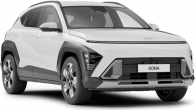There is something genuinely refreshing about Renault’s honest admission that its teeny-tiny Captur is designed for life in the city, and only the city.
While plenty in the small SUV space paint these fantastical images of the off-road adventures awaiting potential owners (mainly to sell said customers complicated four-wheel drive systems they’ll never use), Renault appears to understand its owners are as likely to find themselves negotiating craters on the moon as they are some off-road track, so they don’t bother.
Which is why the Captur is exclusively front-drive. And there's no load-lugging diesel engine on offer, either. Instead, there’s a pair of tiny-capacity petrol engines to choose from. All of which makes perfect sense for a car that will only exist in the city.
.jpg)
The only real risk to all this is that if you only do one thing, you're going to want to be pretty bloody good at it. So for this test we opted for the top-spec Captur Intens model fitted with the bigger of the two engines. And we put it to work in the city.
Renault Captur 2018: Intens
| Engine Type | Turbo 4, 1.2L |
|---|---|
| Fuel Type | Premium Unleaded Petrol |
| Fuel Efficiency | 5.8L/100km (combined) |
| Seating | 5 |
| Price From | $17,820 - $22,550 |
Does it represent good value for the price? What features does it come with?
7 / 10
At $30,990 drive-away, this top-spec Captur is in the right pricing ballpark for front-drive, petrol-powered models in this segment. Our test car also had metallic paint and an upgraded Bose sound system, lifting the as-tested price to $32,090, again, drive-away.
So, what kinds of French niceties are you buying? Well, outside you get 17-inch alloy wheels, the two-tone paint job and a microscopic rear spoiler. You'll also find a sprinkling of chrome, electric wing mirrors and a sunroof.
.jpg)
Inside, expect push-button start, climate control and LED interior lights. Leather seats, a leather-wrapped steering wheel and sat-nav all arrive as standard, too.
On the tech front, a 7.0-inch touchscreen feeds an Arkamys sound system as standard, but our test car was fitted with a six-speaker Bose unit - a $600 option.
.jpg)
Is there anything interesting about its design?
8 / 10
By far the best part of the Captur story is its chic, cute French handbag on shining alloy wheels exterior design.
.jpg)
The two-tone paint job works a treat, with our test car painted a creamy white but with a black roof and a strip along the base of the car that climbs up and into the body as it reaches the rear door. It breaks up the monotony of the otherwise smooth bodywork, and gives the little Captur a sense of youthful exuberance.
Climb inside and you’re met by leather-wrapped seats and soft-touch materials on the door trims, but they're counteracted by the rock-hard plastics that surround the centre screen and gear shift. The entertainment screen does look very good, though; a sleek and modern unit framed by gloss-black plastics and with its major controls integrated into the screen.
.jpg)
There’s a definite air of class in the Captur’s cabin, and there are plenty of little nods to design (like the shape of the air-con controls) that you’d discover over time.
How practical is the space inside?
7 / 10
Well, that depends largely on where you’re sitting. Up front, the room is fine, and the vision from the high driving position is terrific.
There are two cupholders that seperate the front seats (though one is bigger than the other) and a pencil case-sized storage bin in the pulldown armrest that splits the front seats. There’s room in each front door for bottles, too.
Climb into the back, though, and things get tighter. Behind my own (178cm) driving position, you’ll find the knee and headroom is actually pretty good, thanks in part to an arch in the roof, but you’d be a cruel person to squeeze three adults into the backseat.
.jpg)
There are also storage nets on the rear of each front seat, and there’s room in each door for bottles. With no pull-down armrest, there are no cupholders, nor are there any vents, power or USB connections for backseat riders. There are two ISOFX attachment points, one in each window seat.
.jpg)
A removable shelf allows you to alter the height of the boot, under which lives a space-saver spare tyre. You’ll get 377 litres of space with the rear seats in place, swelling to 1235 litres with the rear seats folded flat.
What are the key stats for the engine and transmission?
6 / 10
Calling this engine the 'bigger petrol' is a relative term, given the smaller option is a (almost literally) pint-sized 0.9-litre unit. This one, on the other hand, is a whopping (by comparison) 1.2-litre turbocharged petrol engine (so, two pints).
.jpg)
It will produce 88kW at 4900rpm and 190Nm at 2000rpm (not what you'd call exciting numbers), fired to the front wheels via a six-speed automatic transmission. And as a result of all that, the Captur will clip 0-100km/h in 10.9 seconds and push on to a top speed of 192km/h.
How much fuel does it consume?
8 / 10
Renault claims the Captur consumes a frugal 5.8L/100km on the combined cycle, which is really very good. Emissions are a claimed 130g/km of C02. Our real-world testing returned a figure closer to 7.5L/100km, though.
The 45-litre fuel tank will only except the more expensive 95RON or 98RON premium fuel.
What's it like to drive?
7 / 10
It’s a mixed bag, the Captur. It is perfectly suited to city life: diminutive proportions, easy vision, light steering and plenty of technology. And so it fulfils that core brief perfectly. But unlike a European capital, Aussie city-slickers inevitably venture outside the CBD walls, and it’s there that cracks begin to appear.
When you ask too much of it, you find the engine and gearbox combination is underwhelming, to the point where overtaking on the freeway becomes a long-distance challenge. The steering feels soft and disconnected, too, and the suspension is clearly set up to favour suppleness over sportiness.
Put simply, there's a sponginess to the drive experience that doesn't inspire confidence, and it feels significantly less dynamic than the best in the city-SUV segment.
But the city is its home, and it fulfils its duties there with aplomb. Even as far as small SUVs go, the Captur isn’t exactly a towering example, but the seating position gives you this commanding view of the road that makes you feel like you’re looming above the traffic.
Clever bonnet design makes it fade away from sight, too, and provides a huge, panoramic view of the road ahead, giving you terrific vision. The view out of the rear side windows, though, (like when you're checking your blind spots), is harder.
Warranty & Safety Rating
What safety equipment is fitted? What safety rating?
6 / 10
There are four airbags, all located for front-seat riders, with dual front and front-side bags on offer. They join front and rear parking sensors, a reversing camera and a nifty auto-parking system. You also get blind-spot monitoring, but that's about it as far as advanced safety tech goes, with no AEB, or lane keep assist on offer.
The Renault Captur wears a five-star ANCAP safety rating, but it was earned via a 2013 crash test in Europe. The lack of backseat airbags wouldn't see it fair anywhere near so well under today's testing criteria.
What does it cost to own? What warranty is offered?
8 / 10
Renault has seriously upped its game on the ownership front, and the Captur Intens offers up a five-year/ unlimited kilometre warranty, five years of free roadside assistance and a three-year capped price servicing program.
The Renault Captur Intens requires servicing every 12 months or 30,000km.
Verdict
If you're an inner-city slicker, the chic-looking Captur Intens will likely be all the car you ever need. It's small enough to navigate cramped laneways, easy to park and even easier on the eye. Outside the CBD, though, cracks do begin to appear, so if you're chasing spirited driving or long-distance hauls, the Captur won't quite capture your heart.
Renault Captur or Mazda CX-3? Tell which you'd choose and why in the comments below.
Pricing Guides

.jpg)

.jpg)

.jpg)







.png)









.jpg)


.jpg)

